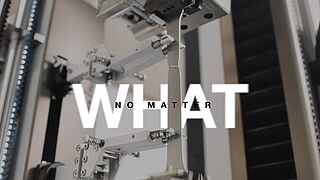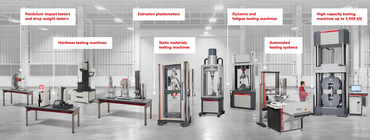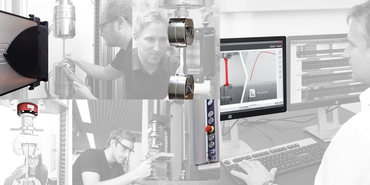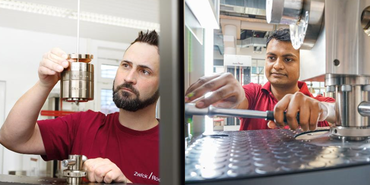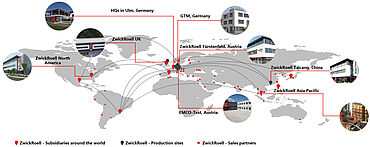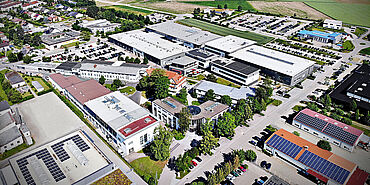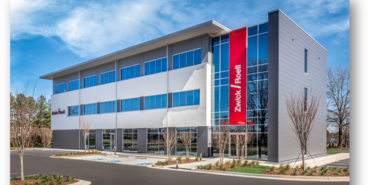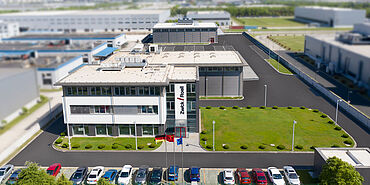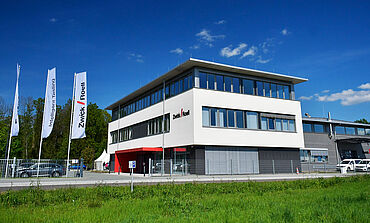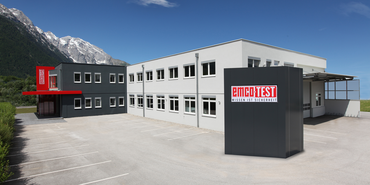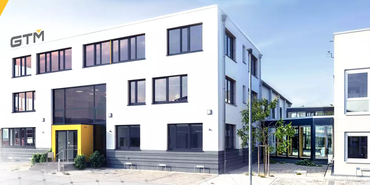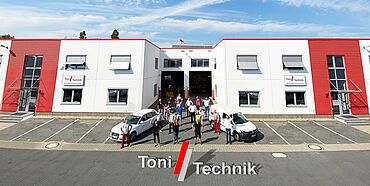ZwickRoell Grubu hakkında bilgiler
ZwickRoell, malzeme testi için dünyanın önde gelen statik malzeme test cihazları tedarikçisidir. Dinamik test alanında, onlarca yıldır yorulma testi sistemleri için başarılı çözümler sunuyoruz. Sac şekillendirme test cihazları, sertlik test makineleri ve cihazlar, erime akış indeksi veya darbe testi için ürünler belirlemek için akış test cihazları olsun - bu uygulamalar için en uygun çözüme sahibiz!
ZwickRoell'in malzeme test cihazları, 20'den fazla endüstride araştırma ve geliştirme ve kalite güvencede kullanılmaktadır. Uzmanlarımız farklı sektörlerin bireysel gereksinimlerini detaylı olarak bilir ve test çözümlerini tam olarak karşılar.
Orta ölçekli aile şirketi Almanya, İngiltere, Çin, Çek Cumhuriyeti ve Avusturya'daki üretim tesislerinin yanı sıra Fransa, İngiltere, İspanya, ABD, Meksika, Brezilya, Türkiye, Singapur, Japonya ve Çin’deki ZwickRoell şubeleri 56 ülkede satış ve servis ortaklarıyla temsil edilmektedir. ZwickRoell Group'un yaklaşık 1.800 çalışanı, malzeme ve bileşen testlerinde olağanüstü teknik performansı, yenilikçiliği, kaliteyi ve güvenilirliği en üst düzeyde tutmak için sürekli çalışıyor.
Bir bakışta ZwickRoell ZwickRoell Yönetim Ekibi ZwickRoell Şirketler Grubu ZwickRoell'in dünya çapındaki bağlantıları
-
Vcard Google Maps İletişim formu
ZwickRoell, Albania
Represented by Ebert d.o.o.Dimiceva 12 1000 Ljubljana Slovenia Europe -
Vcard Google Maps İletişim formu
Technocid S.a.r.l.
Siège Groupe SIDER Zone Supérieure Chaiba, Sidi-Amar, B.P. 62 23220 Annaba Algeria Africa -
Vcard Google Maps
ZwickRoell, Angola
Represented by ZwickRoell GmbH & Co. KGAugust-Nagel-Straße 11 89079 Ulm Germany EuropeHotline: +49 7305 10 11225HR: +49 7305 10 0Fax: +49 7305 10 11200İletişim formu -
Vcard Google Maps İletişim formu
ZwickRoell, Australia
Represented by ZwickRoell Pte. Ltd.18 Boon Lay Way, #06-105/106, TradeHub 21 609966 Singapore Singapore Asia -
Vcard Google Maps
ZwickRoell, Austria
Represented by ZwickRoell GmbH & Co. KGAugust-Nagel-Straße 11 89079 Ulm Germany EuropeHotline: +49 7305 10 11225HR: +49 7305 10 0Fax: +49 7305 10 11200İletişim formu -
Vcard Google Maps İletişim formu
ZwickRoell, Azerbaijan
Represented by ZwickRoell Malzeme Test Sistemleri San. ve Tic. Ltd. Şti.Merkez: Kaya Millenium İş Merkezi, Cumhuriyet Mah. Gürpınar Yolu Cad., No: 5/A C-Blok Kat: 8 Beykent 34500 Büyükçekmece – İSTANBUL Türkiye Europe -
Vcard Google Maps
ZwickRoell, Bahrain
Represented by ZwickRoell GmbH & Co. KGAugust-Nagel-Straße 11 89079 Ulm Germany EuropeHotline: +49 7305 10 11225HR: +49 7305 10 0Fax: +49 7305 10 11200İletişim formu -
Vcard Google Maps İletişim formu
ZwickRoell, Bangladesh
Represented by ZwickRoell Pvt. Ltd.Guindy SKCL ICON, 3rd Floor, C-42&43, CIPET Road, SIDCO Industrial Estate 600 032 Chennai India Asia -
Vcard Google Maps İletişim formu
ZwickRoell, Belgium
Represented by ZwickRoell VenloParlevinkerweg 1 5928 PR Venlo Netherlands Europe -
Vcard Google Maps İletişim formu
ZwickRoell, Bosnia-Herzegowina
Represented by Ebert d.o.o.Dimiceva 12 1000 Ljubljana Slovenia Europe -
Vcard Google Maps
ZwickRoell, Botswana
Represented by ZwickRoell GmbH & Co. KGAugust-Nagel-Straße 11 89079 Ulm Germany EuropeHotline: +49 7305 10 11225HR: +49 7305 10 0Fax: +49 7305 10 11200İletişim formu -
Vcard Google Maps İletişim formu
ZwickRoell Ltda.
Ville Sainte Hélène Rua Ana Viana Silveira Franco, 18 - salas 35 a 38 13105-823 Campinas Brazil South America -
Vcard Google Maps
ZwickRoell, Cameroon
Represented by ZwickRoell GmbH & Co. KGAugust-Nagel-Straße 11 89079 Ulm Germany EuropeHotline: +49 7305 10 11225HR: +49 7305 10 0Fax: +49 7305 10 11200İletişim formu -
Vcard Google Maps
ZwickRoell, Canada
Represented by ZwickRoell LP1009 Market Center Drive NW Kennesaw, GA 30144 United States Northern AmericaHotline: +1(678)- 695-5757İletişim formu -
Vcard Google Maps İletişim formu
Relaf S.R.L.
Region Metropolitana Los Dominicos 8630, of 508, Las Condes 7550000 Santiago Chile South America -
Vcard Google Maps İletişim formu
ZwickRoell Testing Technology (Shanghai) Co., Ltd. 兹位克测试技术(上海)有限公司
上海浦东张江科苑路88号1幢,德国中心1号楼106单元 Unit 106, Tower 1, No. 88 Keyuan Road 201203 Pudong, Shanghai China Asia -
Vcard Google Maps İletişim formu
G. S. Technologies LTDA
Cra 69D ' 1 - 60 Sur Ap1202 In 2 110831330 Bogota Colombia South America -
Vcard Google Maps
ZwickRoell, Congo
Represented by ZwickRoell GmbH & Co. KGAugust-Nagel-Straße 11 89079 Ulm Germany EuropeHotline: +49 7305 10 11225HR: +49 7305 10 0Fax: +49 7305 10 11200İletişim formu -
Vcard Google Maps İletişim formu
ZwickRoell, Croatia
Represented by Ebert d.o.o.Dimiceva 12 1000 Ljubljana Slovenia Europe -
Vcard Google Maps İletişim formu
ZwickRoell s.r.o.
Podnikatelská 2956/6 612 00 Brno Czech Republic Europe -
Vcard Google Maps
ZwickRoell, Denmark
Represented by ZwickRoell GmbH & Co. KGAugust-Nagel-Straße 11 89079 Ulm Germany EuropeHotline: +49 7305 10 11225HR: +49 7305 10 0Fax: +49 7305 10 11200İletişim formu -
Vcard Google Maps İletişim formu
ZwickRoell Ecuador
Represented by CIPEM SRLArismendi 2635 1427 Buenos Aires Argentina South America -
Vcard Google Maps
SADEX Technical Consulting & Agencies
Dream House Building, Loran 6,8 Ahmed Farid Basha Street 21411 Alexandria Egypt AfricaFax: +203 5834536İletişim formu -
Vcard Google Maps
ZwickRoell, Equatorial Guinea
Represented by ZwickRoell GmbH & Co. KGAugust-Nagel-Straße 11 89079 Ulm Germany EuropeHotline: +49 7305 10 11225HR: +49 7305 10 0Fax: +49 7305 10 11200İletişim formu -
Vcard Google Maps İletişim formu
ZwickRoell, Estonia
Represented by ISOmetrija SIAKrustabaznicas 4 1006 Riga Latvia Europe -
Vcard Google Maps İletişim formu
EthioLab Equipment Supply PLC
Adwa street, Arada w-09 R-407 Addis Ababa Ethiopia Africa -
Vcard Google Maps İletişim formu
ZwickRoell S.a.r.l.
4 Rue Royal Canadian Air Force, CS 45191 57530 Ars-Laquenexy France Europe -
Vcard Google Maps
ZwickRoell, Gabon
Represented by ZwickRoell GmbH & Co. KGAugust-Nagel-Straße 11 89079 Ulm Germany EuropeHotline: +49 7305 10 11225HR: +49 7305 10 0Fax: +49 7305 10 11200İletişim formu -
Vcard Google Maps İletişim formu
ZwickRoell, Georgia
Represented by ZwickRoell Malzeme Test Sistemleri San. ve Tic. Ltd. Şti.Merkez: Kaya Millenium İş Merkezi, Cumhuriyet Mah. Gürpınar Yolu Cad., No: 5/A C-Blok Kat: 8 Beykent 34500 Büyükçekmece – İSTANBUL Türkiye Europe -
Vcard Google Maps
ZwickRoell GmbH & Co. KG
August-Nagel-Straße 11 89079 Ulm Germany EuropeHotline: +49 7305 10 11225HR: +49 7305 10 0Fax: +49 7305 10 11200İletişim formu -
Vcard Google Maps
ZwickRoell, Ghana
Represented by ZwickRoell GmbH & Co. KGAugust-Nagel-Straße 11 89079 Ulm Germany EuropeHotline: +49 7305 10 11225HR: +49 7305 10 0Fax: +49 7305 10 11200İletişim formu -
Vcard Google Maps İletişim formu
Elli Avlonitou Vassilis Psimmenos OE
67, N. Elvetias Str 162 33 Byronas Greece Europe -
Vcard Google Maps
ZwickRoell, Guinea
Represented by ZwickRoell GmbH & Co. KGAugust-Nagel-Straße 11 89079 Ulm Germany EuropeHotline: +49 7305 10 11225HR: +49 7305 10 0Fax: +49 7305 10 11200İletişim formu -
Vcard Google Maps İletişim formu
ZwickRoell, Hong Kong
Represented by ZwickRoell Testing Technology (Shanghai) Co., Ltd. 兹位克测试技术(上海)有限公司上海浦东张江科苑路88号1幢,德国中心1号楼106单元 Unit 106, Tower 1, No. 88 Keyuan Road 201203 Pudong, Shanghai China Asia -
Vcard Google Maps İletişim formu
ZwickRoell Pvt. Ltd.
Guindy SKCL ICON, 3rd Floor, C-42&43, CIPET Road, SIDCO Industrial Estate 600 032 Chennai India Asia -
Vcard Google Maps İletişim formu
ZwickRoell Pte. Ltd. Indonesia Representative Office
JL Kapt. Soebianto Djojohadikusumo BSD City, Tangerang Selatan Roseville SOHO & Suite, S1601 Sunburst CBD Lot 1.8 15321 Banten Indonesia Asia -
Vcard Google Maps İletişim formu
Al-Qiffaf Scientific Co.
Al-Sarafia, Quarter 120 street 26 building 7, Bagdad Iraq Asia -
Vcard Google Maps
ZwickRoell, Ireland
Represented by ZwickRoell Ltd.Worcester Six Business Park, Clayfield Road, Worcester WR4 0AE Worcestershire United Kingdom EuropeFax: +44 1568-61 2626İletişim formu -
Vcard Google Maps İletişim formu
GLOBUS Technical Equipment Ltd.
1 Ha'ofe Street 609 2000 Kadima Industrial Zone Israel Asia -
Vcard Google Maps İletişim formu
ZwickRoell S.r.l.
Via Renata Bianchi, 40 piano 3 16152 Genova Italy Europe -
Vcard Google Maps İletişim formu
ZwickRoell Corporation
Kohoku-Ku Shin-Yokohama 3-8-8, No16 Nisso Building 405 222-0033 Yokohama-City Japan Asia -
Vcard Google Maps İletişim formu
Petra Scientific Technologies L.L.C
Al Hurriyah street Building 54, 2nd floor PO Box 151022 Amman Jordan Asia -
Vcard Google Maps
ZwickRoell, Kenya
Represented by ZwickRoell GmbH & Co. KGAugust-Nagel-Straße 11 89079 Ulm Germany EuropeHotline: +49 7305 10 11225HR: +49 7305 10 0Fax: +49 7305 10 11200İletişim formu -
Vcard Google Maps İletişim formu
ZwickRoell, Kosovo
Represented by Ebert d.o.o.Dimiceva 12 1000 Ljubljana Slovenia Europe -
Vcard Google Maps İletişim formu
ZwickRoell, Kuwait
Represented by Emphor Science Technology Trading LLCOffice No. DY 72, Gate No. 2, Al Jadaf, P.O. Box: 6488 Dubai United Arab Emirates Asia -
Vcard Google Maps İletişim formu
AL DIYAR INTERNATIONAL Co. S.A.R.L
2nd floor, Block C5, Hazmieh Commercial Center, Damascus international road, Hazmieh (Baabda) Lebanon Asia -
Vcard Google Maps
ZwickRoell, Libya
Represented by ZwickRoell GmbH & Co. KGAugust-Nagel-Straße 11 89079 Ulm Germany EuropeHotline: +49 7305 10 11225HR: +49 7305 10 0Fax: +49 7305 10 11200İletişim formu -
Vcard Google Maps
ZwickRoell, Liechtenstein
Represented by ZwickRoell GmbH & Co. KGAugust-Nagel-Straße 11 89079 Ulm Germany EuropeHotline: +49 7305 10 11225HR: +49 7305 10 0Fax: +49 7305 10 11200İletişim formu -
Vcard Google Maps İletişim formu
ZwickRoell, Lithuania
Represented by ISOmetrija SIAKrustabaznicas 4 1006 Riga Latvia Europe -
Vcard Google Maps İletişim formu
ZwickRoell, Luxembourg
Represented by ZwickRoell VenloParlevinkerweg 1 5928 PR Venlo Netherlands Europe -
Vcard Google Maps İletişim formu
ZwickRoell, Macao
Represented by ZwickRoell Testing Technology (Shanghai) Co., Ltd. 兹位克测试技术(上海)有限公司上海浦东张江科苑路88号1幢,德国中心1号楼106单元 Unit 106, Tower 1, No. 88 Keyuan Road 201203 Pudong, Shanghai China Asia -
Vcard Google Maps İletişim formu
Inno Lab Engineering Sdn. Bhd.
Subang Permai Industrial Estate No. 3, Level 1 & 2, Jalan USJ 1/31 47160 Subang Jaya Malaysia Asia -
Vcard Google Maps İletişim formu
ZwickRoell, Malta
Represented by ZwickRoell S.r.l.Via Renata Bianchi, 40 piano 3 16152 Genova Italy Europe -
Vcard Google Maps
ZwickRoell, Mauritius
Represented by ZwickRoell GmbH & Co. KGAugust-Nagel-Straße 11 89079 Ulm Germany EuropeHotline: +49 7305 10 11225HR: +49 7305 10 0Fax: +49 7305 10 11200İletişim formu -
Vcard Google Maps
ZwickRoell S.A. de C.V.
Av. Santa Fe 170, Lomas de Santa Fe 01210 Ciudad de México Mexico Northern AmericaHotline: + 52 (55) 5292 4483 ext 103İletişim formu -
Vcard Google Maps İletişim formu
ZwickRoell, Montenegro
Represented by Ebert d.o.o.Dimiceva 12 1000 Ljubljana Slovenia Europe -
Vcard Google Maps İletişim formu
ZwickRoell, Morocco
Represented by ZwickRoell S.a.r.l.4 Rue Royal Canadian Air Force, CS 45191 57530 Ars-Laquenexy France Europe -
Vcard Google Maps İletişim formu
ZwickRoell, Myanmar
Represented by ZwickRoell Pte. Ltd.18 Boon Lay Way, #06-105/106, TradeHub 21 609966 Singapore Singapore Asia -
Vcard Google Maps İletişim formu
ZwickRoell, New Zealand
Represented by ZwickRoell Pte. Ltd.18 Boon Lay Way, #06-105/106, TradeHub 21 609966 Singapore Singapore Asia -
Vcard Google Maps İletişim formu
Omakib Integrated Services
Okejigbo Abeokuta Nig. Ltd 73b Ayodeji Street Ogun State Nigeria Africa -
Vcard Google Maps İletişim formu
ZwickRoell, North Macedonia
Represented by Ebert d.o.o.Dimiceva 12 1000 Ljubljana Slovenia Europe -
Vcard Google Maps İletişim formu
ZwickRoell, Oman
Represented by Emphor Science Technology Trading LLCOffice No. DY 72, Gate No. 2, Al Jadaf, P.O. Box: 6488 Dubai United Arab Emirates Asia -
Vcard Google Maps İletişim formu
Techno World Instrument Service
Osif Center, Gulshan-e-Iqbal Office # E-7, Block 13-A/1 Karachi Pakistan Asia -
Vcard Google Maps İletişim formu
ZwickRoell Paraguay
Represented by CIPEM SRLArismendi 2635 1427 Buenos Aires Argentina South America -
Vcard Google Maps
Laboratorio Verifica SAC
Pasaje Las Ágatas 161, 15034 Lima Peru South AmericaSales: +51 948 489 558Email: ventas@verificaciones.peİletişim formu -
Vcard Google Maps İletişim formu
Gryke Scientific Instruments Trading
Serverina Km. 18 237-B Worth Drive Street, Savvy 25 Subdivision 1700 Paranaque City Philippines Asia -
Vcard Google Maps İletişim formu
ZwickRoell Sp. z o.o. Sp. k.
ul. Muchoborska 18 54-424 Wroclaw Poland Europe -
Vcard Google Maps İletişim formu
Gravimeta Lda.
Rua da Vilarinha, 1235 4100-517 Porto Portugal Europe -
Vcard Google Maps İletişim formu
Qatar Scientific Co WLL
Office #704, 7th Floor, Bin Dirham Plaza, B-Ring Road Doha Qatar Asia -
Vcard Google Maps İletişim formu
Sartorom Impex Srl.
Sos. Bucuresti-Magurele, nr. 232 051434 Bucuresti, Sector 5 Romania Europe -
Vcard Google Maps
ZwickRoell, Saudi Arabia
Represented by SADEX Technical Consulting & AgenciesDream House Building, Loran 6,8 Ahmed Farid Basha Street 21411 Alexandria Egypt AfricaFax: +203 5834536İletişim formu -
Vcard Google Maps
ZwickRoell, Senegal
Represented by ZwickRoell GmbH & Co. KGAugust-Nagel-Straße 11 89079 Ulm Germany EuropeHotline: +49 7305 10 11225HR: +49 7305 10 0Fax: +49 7305 10 11200İletişim formu -
Vcard Google Maps İletişim formu
ZwickRoell, Serbia
Represented by Ebert d.o.o.Dimiceva 12 1000 Ljubljana Slovenia Europe -
Vcard Google Maps İletişim formu
ZwickRoell Pte. Ltd.
18 Boon Lay Way, #06-105/106, TradeHub 21 609966 Singapore Singapore Asia -
Vcard Google Maps İletişim formu
ZwickRoell, Slovakian Republic
Represented by ZwickRoell s.r.o.Podnikatelská 2956/6 612 00 Brno Czech Republic Europe -
Vcard Google Maps İletişim formu
AVATAR Solutions
28 Mercury Street, Farrarmere 1501 Benoni South Africa Africa -
Vcard Google Maps İletişim formu
ZwickRoell Services LLC
E-403, Bundang Technopark, 700 Pangyo-ro, Bundang-gu, 13516 Seongnam-si, Gyeonggi-do South Korea Asia -
Vcard Google Maps
MTM Corporation
Songpa-gu A-502, SK V1 GL Metrocity, 128, Beobwon-ro 05854 Seoul South Korea AsiaFax: +82 (2) 527 0336İletişim formu -
Vcard Google Maps İletişim formu
ZwickRoell S.L.
Parc Empresarial Trade Center Av. Corts Catalanes, 5-7, Pl. 2 Loc. 1 08173 Sant Cugat del Vallès (Barcelona) Spain Europe -
Vcard Google Maps İletişim formu
ZwickRoell, Sri Lanka
Represented by ZwickRoell Pvt. Ltd.Guindy SKCL ICON, 3rd Floor, C-42&43, CIPET Road, SIDCO Industrial Estate 600 032 Chennai India Asia -
Vcard Google Maps
ZwickRoell, Sudan
Represented by SADEX Technical Consulting & AgenciesDream House Building, Loran 6,8 Ahmed Farid Basha Street 21411 Alexandria Egypt AfricaFax: +203 5834536İletişim formu -
Vcard Google Maps İletişim formu
ZRS Testing Systems AB
Uggledalsvägen 21 427 40 Billdal Sweden Europe -
Vcard Google Maps
ZwickRoell, Switzerland
Represented by ZwickRoell GmbH & Co. KGAugust-Nagel-Straße 11 89079 Ulm Germany EuropeHotline: +49 7305 10 11225HR: +49 7305 10 0Fax: +49 7305 10 11200İletişim formu -
Vcard Google Maps İletişim formu
ANAS Co. For Medical & Lab Supplies
P.O. Box 13434 Al-Mazraa Area-Ibn Al-Awam St. Damascus Syria Asia -
Vcard Google Maps İletişim formu
ZwickRoell Pte. Ltd. Taiwan Branch Office
Xitun Dist. 10F-3, No.201, Sec.2, Wenxin Rd 40758 Taichung Taiwan Asia -
Vcard Google Maps
ZwickRoell, Tanzania
Represented by ZwickRoell GmbH & Co. KGAugust-Nagel-Straße 11 89079 Ulm Germany EuropeHotline: +49 7305 10 11225HR: +49 7305 10 0Fax: +49 7305 10 11200İletişim formu -
Vcard Google Maps İletişim formu
SCS Instruments Co. Ltd.
Salathamasop, Thaweewathana 178/57 Soi Buddhamonthon, Sai 2 Soi 33 10170 Bangkok Thailand Asia -
Vcard Google Maps İletişim formu
ZwickRoell, Tunisia
Represented by Technocid S.a.r.l.Siège Groupe SIDER Zone Supérieure Chaiba, Sidi-Amar, B.P. 62 23220 Annaba Algeria Africa -
Vcard Google Maps İletişim formu
ZwickRoell Malzeme Test Sistemleri San. ve Tic. Ltd. Şti.
Merkez: Kaya Millenium İş Merkezi, Cumhuriyet Mah. Gürpınar Yolu Cad., No: 5/A C-Blok Kat: 8 Beykent 34500 Büyükçekmece – İSTANBUL Türkiye Europe -
Vcard Google Maps İletişim formu
ZwickRoell Malzeme Test Sistemleri San. ve Tic. Ltd. Şti.
Showroom: Birlik OSB 3. Cadde No: 73 34524 Beylikdüzü – İSTANBUL Türkiye Europe -
Vcard Google Maps İletişim formu
ZwickRoell, Turkmenistan
Represented by ZwickRoell Malzeme Test Sistemleri San. ve Tic. Ltd. Şti.Merkez: Kaya Millenium İş Merkezi, Cumhuriyet Mah. Gürpınar Yolu Cad., No: 5/A C-Blok Kat: 8 Beykent 34500 Büyükçekmece – İSTANBUL Türkiye Europe -
Vcard Google Maps
ZwickRoell, Uganda
Represented by ZwickRoell GmbH & Co. KGAugust-Nagel-Straße 11 89079 Ulm Germany EuropeHotline: +49 7305 10 11225HR: +49 7305 10 0Fax: +49 7305 10 11200İletişim formu -
Vcard Google Maps İletişim formu
ZwickRoell, Ukraine
vul. B. Chmelnyzkyj 14a 49083 Dnipro Ukraine Europe -
Vcard Google Maps İletişim formu
Emphor Science Technology Trading LLC
Office No. DY 72, Gate No. 2, Al Jadaf, P.O. Box: 6488 Dubai United Arab Emirates Asia -
Vcard Google Maps
ZwickRoell Ltd.
Worcester Six Business Park, Clayfield Road, Worcester WR4 0AE Worcestershire United Kingdom EuropeFax: +44 1568-61 2626İletişim formu -
Vcard Google Maps
ZwickRoell LP
1009 Market Center Drive NW Kennesaw, GA 30144 United States Northern AmericaHotline: +1(678)- 695-5757İletişim formu -
Vcard Google Maps İletişim formu
ZwickRoell Uruguay
Represented by CIPEM SRLArismendi 2635 1427 Buenos Aires Argentina South America -
Vcard Google Maps İletişim formu
ESIL C.A.
Urb. Caimito 2, Manzana 19-B, Casa N°25 Puerto Ordaz Venezuela South America -
Vcard Google Maps İletişim formu
ZwickRoell Pte. Ltd. Vietnam Representative Office
Tan Binh District Room No. 1 - Mezzanine, Etown Building, 364 Cong Hoa Street Ho Chi Minh City Vietnam Asia -
Vcard Google Maps İletişim formu
MIT Technologies Joint Stock Company
My Dinh 2 Ward, Nam Tu Liem district CT5-ĐN1 Building, Tran Huu Duc Street Hanoi Vietnam Asia -
Vcard Google Maps
ZwickRoell, Yemen
Represented by ZwickRoell GmbH & Co. KGAugust-Nagel-Straße 11 89079 Ulm Germany EuropeHotline: +49 7305 10 11225HR: +49 7305 10 0Fax: +49 7305 10 11200İletişim formu
